Analysis of the Dynamical Properties of Discrete Predator-Prey Systems with Fear Effects and Refuges
Abstract
This paper examines the dynamic behavior of a particular category of discrete predator-prey system that feature both fear effect and refuge, using both analytical and numerical methods. The critical coefficients and properties of bifurcating periodic solutions for Flip and Hopf bifurcations are computed using the center manifold theorem and bifurcation theory. Additionally, numerical simulations are employed to illustrate the bifurcation phenomenon and chaos characteristics. The results demonstrate that period-doubling and Hopf bifurcations are two typical routes to generate chaos, as evidenced by the calculation of the maximum Lyapunov exponents near the critical bifurcation points. Finally, a feedback control method is suggested, utilizing feedback of system states and perturbation of feedback parameters, to efficiently manage the bifurcations and chaotic attractors of the discrete predator-prey model.
1. Introduction
In exploring population dynamics, continuum modelling is often used to explain population trends in situations where populations are large or where there are overlapping generations [1, 2]. However, when there is no overlap between generations of a population, the growth pattern of the population will show obvious stages and discontinuities. In this case, a discrete model can more accurately capture and reflect this discontinuity in population change. Discrete predator-prey systems can exhibit complex dynamical behavior, which has attracted many researchers to study them [3–6]. Zhang et al. [7] studied the dynamics of a discrete FitzHugh–Nagumo model by applying central manifold and normal form analysis and demonstrated that the system is capable of undergoing Neimark–Sacker and flip bifurcations even in the absence of diffusion. Li et al. [8] obtained rich dynamic properties by building a space-time discrete model with periodic boundary conditions. Therefore, discrete dynamical systems can have more complex dynamics, and their dynamic behavior can more closely approximate the complex dynamics of the phenomena represented by the model.
Since the biological population itself is a complex nonlinear system, this nonlinearity is the fundamental cause of the occurrence of chaos [9, 10]. Through the study of biological groups, we can see that there are many chaotic behaviors embedded in them [11]. Such chaotic phenomena are not limited to animal reproduction and evolution, such as competition and parasitism between the groups [12]. However, chaos in biological groups is not all good, and the negative chaotic situations that exist in nature can have a negative effect on human survival and development; therefore, controlling these chaotic situations is important for maintaining the stability of the ecosystem [13–17]. Discrete systems have two special bifurcations, flip bifurcation and Hopf bifurcation, which in turn are the two ways for discrete systems to move towards chaos. There are now many ways of controlling the chaos generated by the model: Vinoth et al. [18] describe three different approaches to chaos control: state feedback, pole placement, and hybrid control. Nowadays, nature, because of prolonged disturbances, has destroyed its natural rules of reproduction and put it on the verge of extinction, so it is important to carry out the study of chaos control of biological groups with important theoretical and practical application value.
This paper focuses on analyzing the model bifurcation and chaotic properties. In the first part, the existence and stability of the equilibrium point are discussed. In the second and third parts, the conditions for the existence of flip and Hopf bifurcation at the positive equilibrium point are considered, and the direction of the flip and Hopf bifurcation at the positive equilibrium point is derived by using the central manifold theorem. In the fourth part, the maximum Lyapunov exponent is used to discuss the occurrence of chaotic situations inside the system and to control the resulting chaotic situations, and finally, numerical simulations verify the correctness of the theoretical proofs.
2. Existence and Stability of Equilibrium Points
It is evident that system (3) possesses a trivial equilibrium point N0(0, 0) and a boundary equilibrium point N1(α/b, 0).
Assuming (H1) : cβ − ar > 0
If (H1) holds, the only positive equilibrium point of the system can be obtained as N∗(x∗, y∗), where x∗ = r/(cβ − ar)(1 − m), , .
To investigate the stability analysis of the equilibrium point of system (3), we present the following lemma. By utilizing the connections between the coefficients and roots of a quadratic equation [32], one can readily derive the following results.
Lemma 1. Assume that F(λ) = λ2 − Aλ + B and F(1) > 0 with λ1, λ2 are roots of F(λ) = 0. Then, the following results hold true:
- (i)
|λ1| < 1 and |λ2| < 1 if and only if F(−1) > 0, B < 1.
- (ii)
|λ1| < 1 and |λ2| > 1, or |λ1| > 1 and |λ2| < 1 if and only if F(−1) < 0.
- (iii)
|λ1| > 1 and |λ2| > 1 if and only if F(−1) < 0, B > 1.
- (iv)
λ1 and λ2 are complex and |λ1| = 1, |λ2| = 1 if and only if A2 − 4B < 0 and B = 1.
Theorem 2. For the trivial equilibrium point N0(0, 0), the characteristic equation of system (3) at N0(0, 0) has two eigenvalues, λ1 = 1 + hα and λ2 = 1 − hr
- (i)
If h < 2/r, then |λ1| > 1, |λ2| < 1, N0(0, 0) is a saddle point.
- (ii)
If h > 2/r, then |λ1| > 1, |λ2| > 1, N0(0, 0) is a source.
Theorem 3. For the boundary equilibrium point N1(α/b, 0), the characteristic equation of system (3) at N1(α/b, 0) has the eigenvalue λ1 = 1 − hα, λ2 = 1 + h(−r + cβ(1 − m)α/b + a(1 − m)α), let l = (cβ − aα)(1 − m)
- (i)
If , then |λ1| < 1, |λ2| < 1, N1(α/b, 0) is a sink.
- (ii)
If , then |λ1| > 1, |λ2| < 1, or if , then |λ1| < 1, |λ2| > 1, N1(α/b, 0) is a saddle point.
- (iii)
If or , then |λ1| > 1, |λ2| > 1, N1(α/b, 0) is a source.
Theorem 4. For the point N∗(x∗, y∗)
- (i)
If , then |λ1| < 1, |λ2| < 1, N∗(x∗, y∗) is a sink.
- (ii)
If , then |λ1| < 1 and |λ2| > 1, or |λ1| > 1 and |λ2| < 1, N∗(x∗, y∗) is a saddle point.
- (iii)
If , then |λ1| > 1 and |λ2| > 1, N∗(x∗, y∗) is a source.
- (iv)
If , then λ1, λ2 is a pair of conjugate complex roots.
To validate the accuracy of the theoretical proof, numerical simulations are conducted in the following sections. When the parameters are taken as h = 0.1, c = 0.9, r = 0.1, b = 0.01, d = 0.82146, e = 0.9, a = 0.5, K = 34.555, m = 0.89, Theorem 4 of (i) is satisfied, see Figure 1.
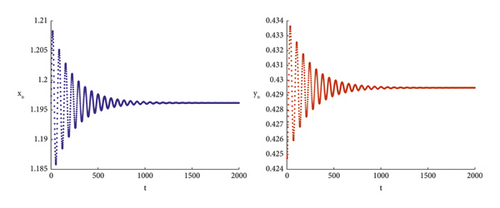
With other parameters are kept constant, let K = 15, through the image can be obtained when the degree of fear is different, the final stability of the system is different, see Figure 2.

3. Flip Bifurcation at Positive Equilibrium Point
3.1. Conditions for the Existence of Flip Bifurcation
Since the step size h > 0, it is possible to obtain the branching value . Here,
If , flip bifurcation occurs at the positive equilibrium point N∗(x∗, y∗).
3.2. The Normal Form of Flip Bifurcation Solutions
During our analysis, we will utilize the central manifold theorem and normal form theory to investigate the direction of the flip bifurcation at the point N∗(x∗, y∗).
Theorem 5. The system exhibits a flip bifurcation at the immobile point N∗(x∗, y∗) if both θ1 and θ2 are nonzero, and it is stable (unstable) at that point with a period of 2 if θ2 > 0(<0).
Proof. In a sufficiently small neighborhood with parameter δ = 0, there exists a central manifold located at (0, 0):
Substituting (24) into (20), the solution is given as
By focusing on the system of equations at Wc(0, 0), we can derive the following outcome:
Based on the reference [33], it is stated that when considering values at (N, P, δ) = (0, 0, 0) and having θ1 ≠ 0, θ2 ≠ 0, the system exhibits a flip bifurcation at the fixed point N∗(x∗, y∗). If θ2 > 0(<0), the point with a period of 2 is stable (unstable).
which
This completes the proof.
To validate the accuracy of the theoretical proof, numerical simulations are conducted in the following sections. When the parameters are taken as h = 4.05937004, r = 0.8, d = 0.5, c = 0.9, b = 0.02, e = 0.6, a = 0.6, K = 9.99, m = 0.46, (7) is satisfied; see Figure 3.
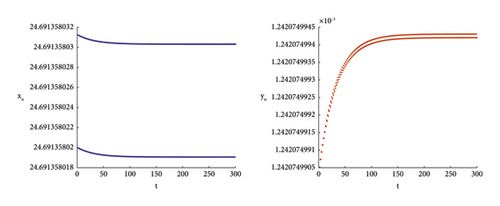
Remark 6. From an ecological perspective, the occurrence of a flip bifurcation is characterized by population size fluctuating in cycles of 2, 4, 8, and so on until a chaotic state is reached. This phenomenon implies that prey populations cannot maintain stability, ultimately resulting in an ecological imbalance.
4. Hopf Bifurcation at Positive Equilibrium Point
4.1. Existence Conditions for Hopf Bifurcation
If s(0) ≠ 0, 1, we have , , where n = 1, 2, 3, 4.
If , Hopf bifurcation occurs at the positive equilibrium point N∗(x∗, y∗).
4.2. Normal Form of Hopf Bifurcation at Positive Equilibria
Theorem 7. If s(0) ≠ 0, 1 and M ≠ 0, a Hopf bifurcation occurs at a positive equilibrium point N∗(x∗, y∗). Moreover, if M < 0, an attracting invariant closed curve bifurcates from the equilibrium point for δ > 0. On the other hand, if M > 0, a repelling invariant closed curve bifurcates from the equilibrium point for δ < 0.
To validate the accuracy of the theoretical proof, numerical simulations are conducted in the following sections. When the parameters are taken as h = 0.168989, r = 0.2, K = 4.94, d = 0.8, c = 0.8, b = 0.01, e = 0.5, a = 0.5, m = 0.76, (7) is satisfied; see Figure 4.
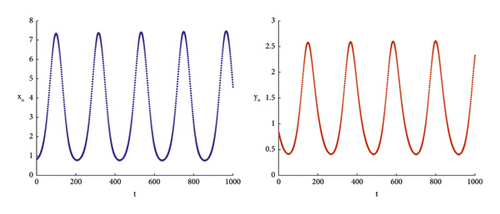
Remark 8. From an ecological perspective, as the parameter h approaches the critical value h∗, a stable curve emerges at the equilibrium point N∗(x∗, y∗), indicating a stable coexistence between the prey and predator populations. Conversely, if the constant curve at the equilibrium point N∗(x∗, y∗) becomes unstable as h increases, the populations of prey and predators will fail to reach a stable state, leading to an ecological imbalance within the ecosystem.
5. Chaotic Analysis
In general, flip bifurcation and Hopf bifurcation are two ways in which discrete systems move towards chaos. Under the condition of the existence of two kinds of bifurcations, applying perturbations to the bifurcation parameters, sometimes a chaotic situation occurs, which is discussed in the following.
5.1. Existence of Chaos
Definition 9 (see [34].)For the system xn+1 = f(xn), yn+1 = f(yn), if a small perturbation is applied to the system, the system will diverge as the number of iterations increases, and the degree of divergence is usually expressed using the maximum Lyapunov index, which is given by
Theorem 10 (see [34].)If λ < 0, it is an indication that neighboring points will eventually converge to a single point. This is the equivalent of stable, motionless points and periodic motion. On the other hand, if λ > 0, it means that neighboring points will eventually separate from each other. This means that orbits are locally unstable and chaotic.
After selecting the perturbation δ = (0, 1.5), the trend of x is analyzed numerically, and through numerical simulation, the maximum Lyapunov exponential map agrees with the trend of the bifurcation map, see Figures 5-7.
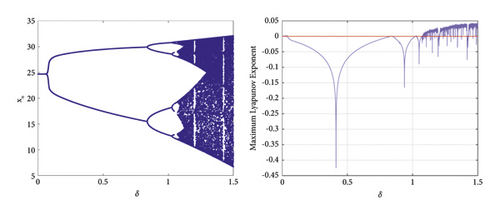
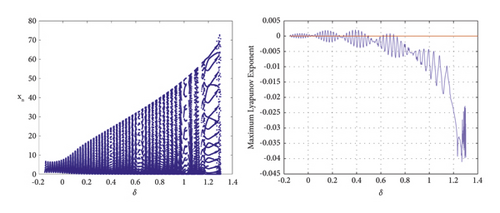
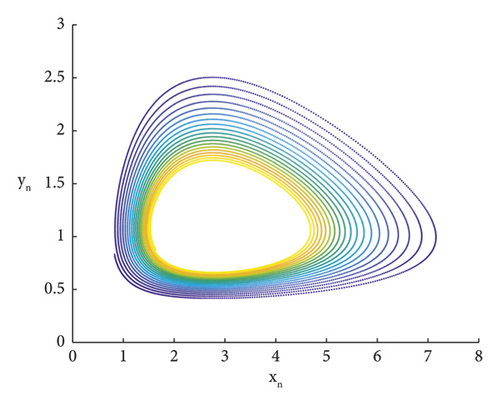
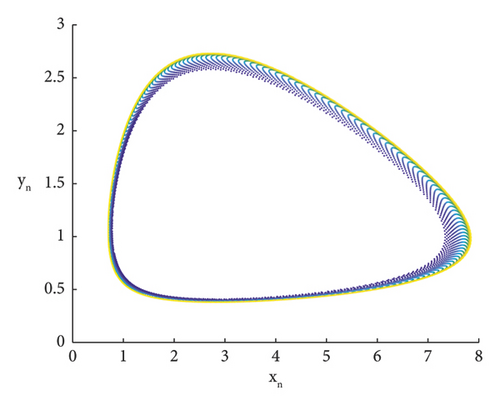
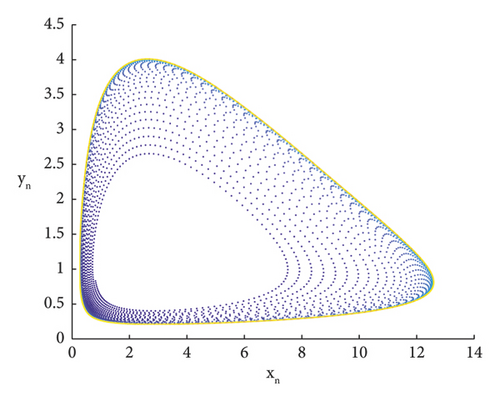
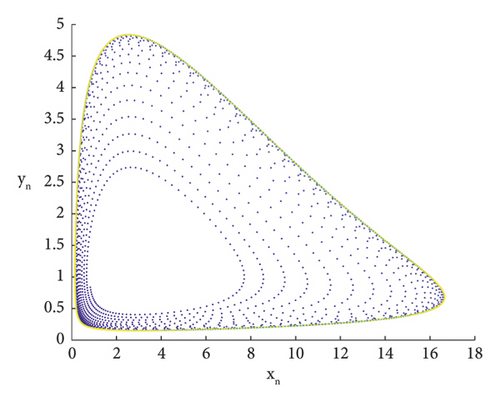
5.2. Chaos Control
The feedback control is defined as Un = σ(xn − x∗) + θ(yn − y∗), where σ and θ are the feedback gains and N∗(x∗, y∗) represents the only positive equilibrium point of the system.
To determine the lines of marginal stability, we need to solve the equations λ1 = ±1 and λ1λ2 = 1. These equations impose constraints that guarantee the absolute values of λ1 and λ2 are both less than 1. By finding the solutions to these equations, we can identify the boundaries of stability.
Assume that λ1λ2 = 1, it is possible to obtain L1 : J11J22 − J21J12 − 1 = σJ22 − θJ21.
Next, assuming λ1 = 1, one obtains L2 : σ(1 − J22) + θJ21 = J11 + J22 − 1 − J11J22 + J21J12.
Assuming λ1 = −1, one obtains L3 : σ(1 + J22) − θJ21 = J11 + J22 + 1 + J11J22 − J21J12.
It is evident that, for specific parameter values, the stable eigenvalues are situated within the triangular region defined by the straight lines L1, L2, L3; see Figures 8 and 9. By selecting the appropriate parameter values in the restricted area, it becomes apparent that the perturbation values increase significantly when chaos emerges within the controlled region;, see Figures 10 and 11. Furthermore, the temporal evolution of the population numbers, both before and after implementing control measures, can be effectively validated through visual representations; see Figures 12 and 13.
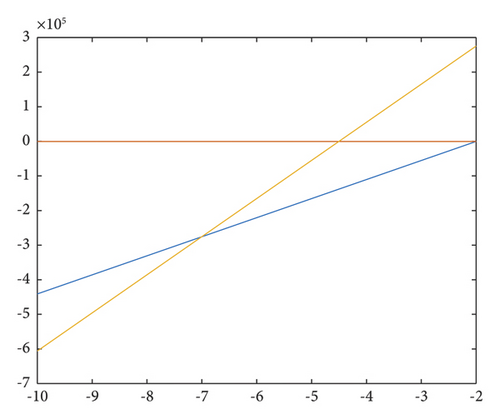
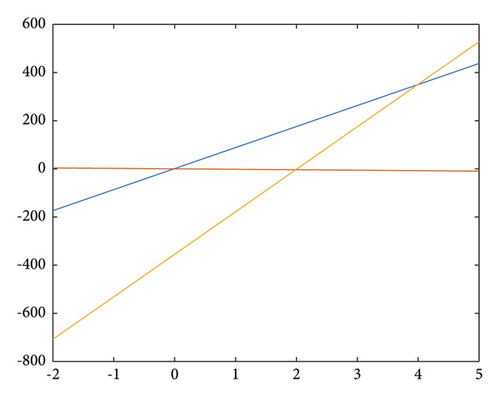
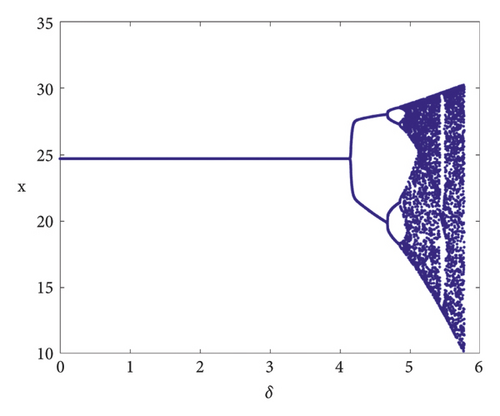
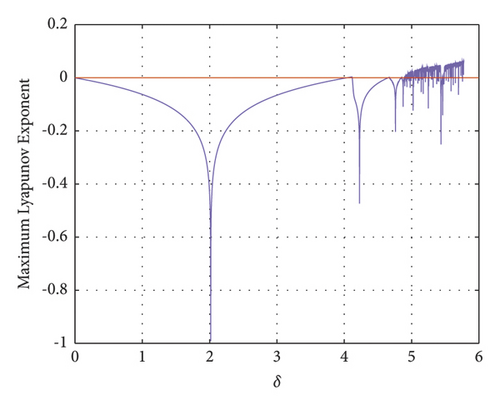
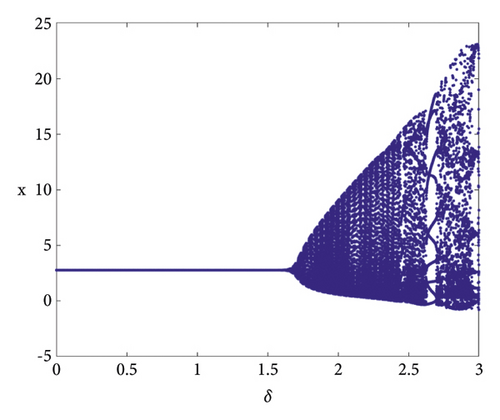
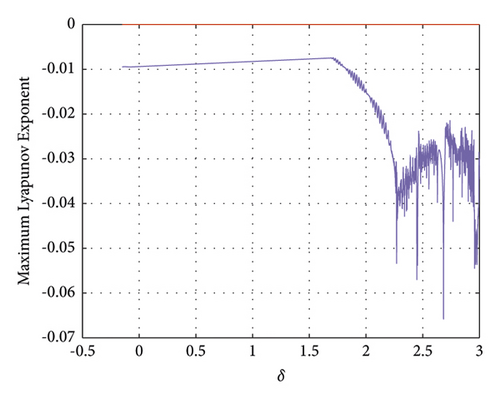
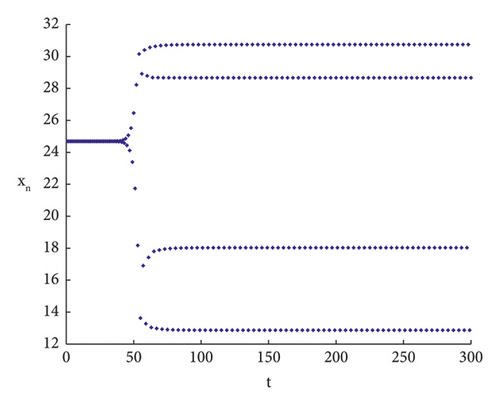
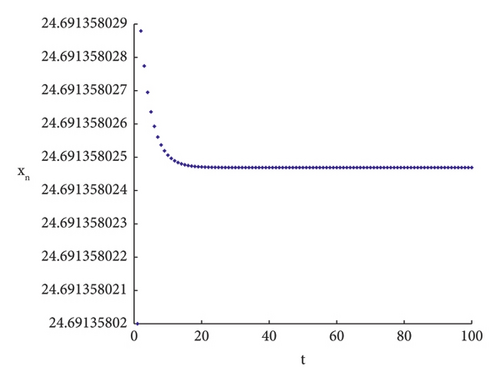

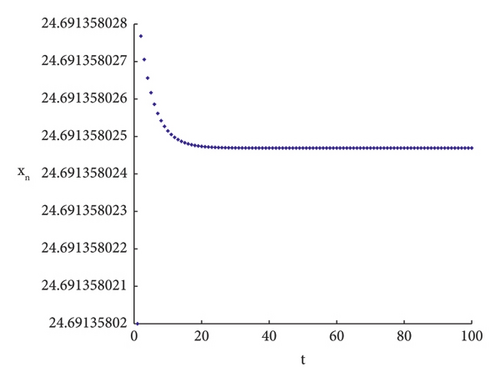
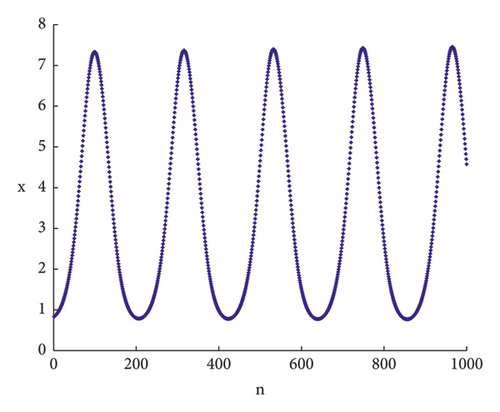
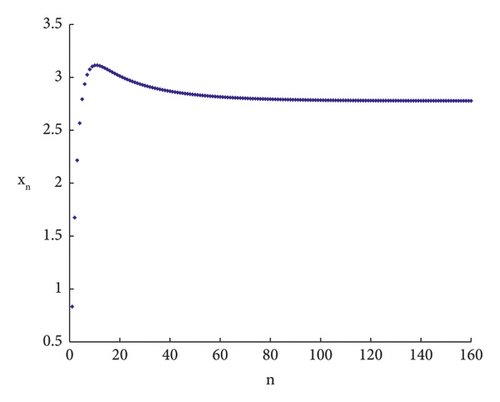
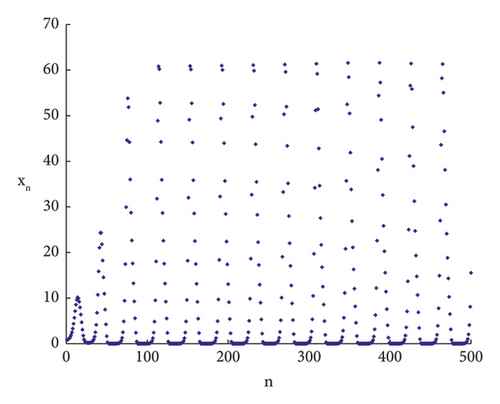
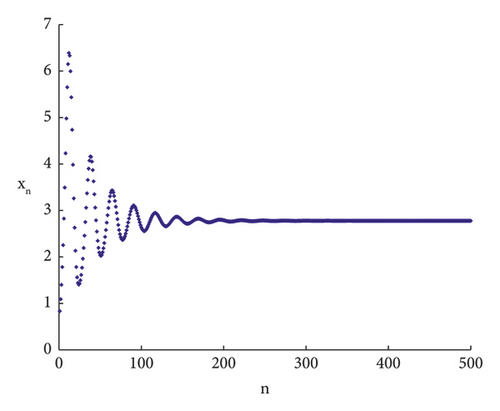
Remark 11. From the ecological point of view, when unfavourable chaos occurs, the antidisturbance ability of the ecosystem is greatly enhanced by carrying out chaos control, which is conducive to maintaining the stability of the ecosystem and reducing the problem of ecological imbalance. As an example, greening and the establishment of biological shelters can effectively reduce the state of chaos among groups of organisms, thus effectively protecting and managing the diversity of species.
6. Conclusion
In this paper, we investigate a discrete predator-prey model incorporating fear effects and refuge. We begin by discussing the local stability and instability conditions of the three equilibrium points of system (3). Specifically, we analyze the occurrence of flip bifurcation at eigenvalues |λ1| = −1 and |λ2| < 1 of characteristic (6). Additionally, we explore the Hopf bifurcation that arises when the eigenvalues of characteristic (6) form a pair of conjugate unit complex roots. We also examine the bifurcation directions associated with these two types of bifurcations.
The chaotic behavior of the system is investigated through both theoretical proofs and numerical simulations. We demonstrate that chaotic dynamics can be controlled using the feedback control method. Bifurcation diagrams and maximum Lyapunov exponent diagrams clearly illustrate the significant increase in perturbation values when system (3) exhibits chaos after control.
From a biological perspective, the stability analysis of the equilibrium points reveals that, under the influence of fear and other factors, the predator and prey populations eventually reach an equilibrium state, allowing for harmonious coexistence. By controlling the chaotic situations arising from flip and Hopf bifurcations, we can effectively suppress chaotic behavior among organisms. This can be achieved through various human-imposed interventions such as greening, establishing biological refuges, and implementing other measures. These interventions are beneficial for the survival and development of biological populations.
In future research, it would be worthwhile to explore different chaos control methods in order to achieve improved control effects.
Conflicts of Interest
The authors declare that they have no conflicts of interest.
Authors’ Contributions
The idea of this research was introduced by W. Li. All the authors contributed to the main results and numerical simulations. C. Zhang and M Wang contributed to revising the manuscript.
Acknowledgments
This research was supported by the Fundamental Research Funds for the Central Universities (no. 60201523050).
Open Research
Data Availability
No data were used to support the findings of this study.




